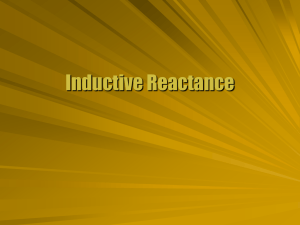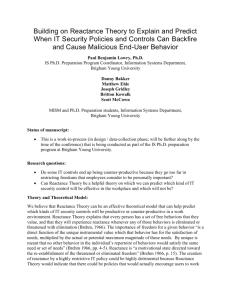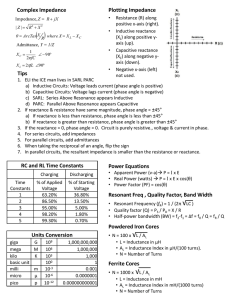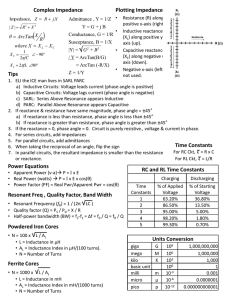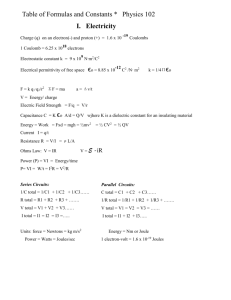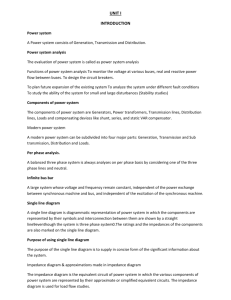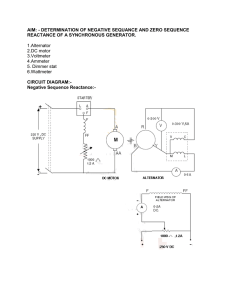-
advertisement
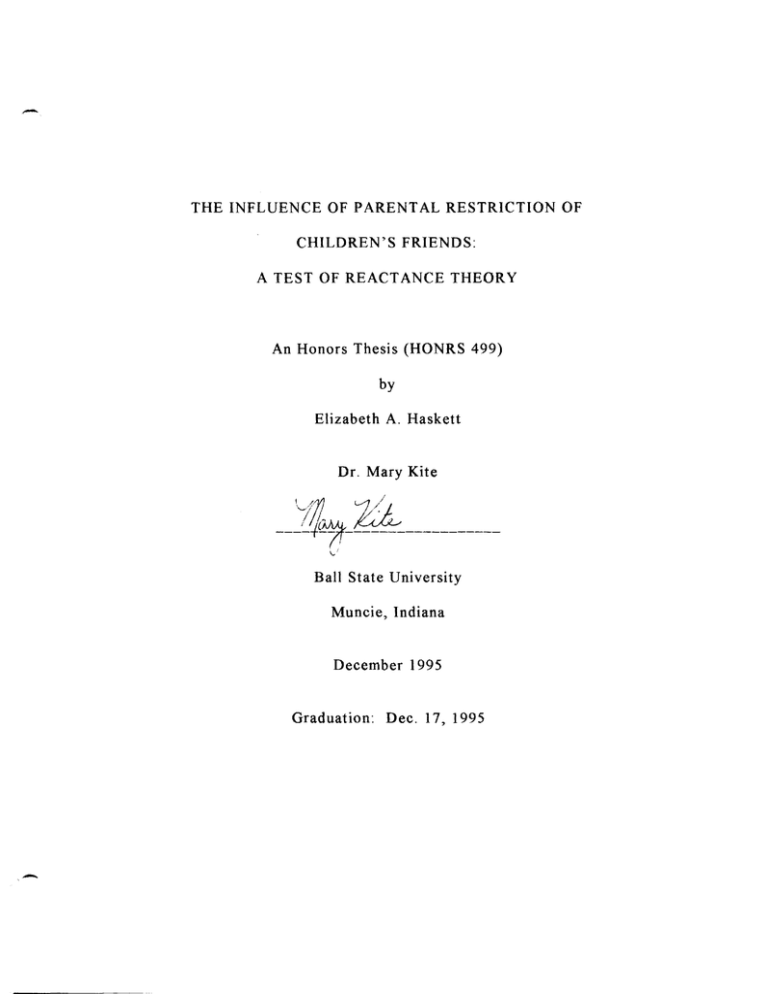
THE INFLUENCE OF PARENTAL RESTRICTION OF CHILDREN'S FRIENDS: A TEST OF REACT ANCE THEORY An Honors Thesis (HONRS 499) by Elizabeth A. Haskett Dr. Mary Kite 177 U __1!+~ ___~_~___________ \./ Ball State University Muncie, Indiana December 1995 Graduation: Dec. 17, 1995 .- -I l LJ Children & Reactance 2 Abstract Telling people not to do something often produces the opposite reaction_ Psychological reactance, as described by Brehm and Brehm (1981), proposes that this process occurs because of a motivational force to restore lost or threatened freedoms. The present study was designed to test the reactance theory as it applies to adolescents' reactions to restrictions of freedom by their parents. It was predicted that adolescents would like deviant friends more when the friendship was forbidden by parents than when it was not forbidden. Results marginally supported this hypothesis_ Specifically, eighthgraders reported that another student would like a friend who is caught smoking cigarettes more when the student's parents specifically forbid the friendship than when the student's parents gave the child the freedom to choose whether he/she would remain friends with the smoker. - ,- Children & Reactance 3 THE INFLUENCE OF PARENTAL RESTRICTION OF CHILDREN'S FRIENDS: A TEST OF REACTANCE THEORY Telling people not to do something often produces the opposite reaction. People seem to need a sense of control over their lives. Psychological reactance, as described by Brehm and Brehm (1981), proposes that this process occurs because of a motivational force to restore lost or threatened freedoms. According to reactance theory, when an individual who expects to be able to control events is exposed instead to an uncontrollable outcome, the result is reactance arousal and increased striving for control as the person engages in protective or restorative behaviors. The more important the freedom, the greater will be the attempt to engage in behaviors to restore that freedom. If the cost of noncompliance is not too high, the individual may choose to directly engage in the prohibited behavior. If the behavior cannot be directly reestablished, the individual may engage in the restoration of freedom by watching others perform the threatened behavior, by engaging in behaviors similar to the one that is threatened, or by simply experiencing increased attraction to the threatened behavior (Brehm & Brehm, - - Children & Reactance 4 1981). In any case, a sense of personal control and power appears to be important to most people's construction of their own reality. It seems logical that perceiving oneself as lacking in control would be deeply frightening and most people would likely go to considerable lengths to deny or to change that reality. Past research supports these propositions. Mazis (1975) investigated housewives' responses to the imposition of an antiphosphate ordinance in Miami, Florida. The ordinance prohibited the sale, possession, or use of cleaning products containing phosphates. Housewives completed questionnaires and interviews designed to determine their attitudes about cleaning supplies and their opinions about laws regulating the use of phosphates. As was predicted, deprived housewives expressed more positive attitudes about the effectiveness of phosphate products and more negative attitudes about governmental regulations of environmental matters. Apparently, people have reduced attractiveness to forced alternatives (Mazis, 1975). Not only do people find a forced behavior less attractive:. but they also find the eliminated behavior or object more attractive than previously (West, 1975). To demonstrate this, college students who - Children & Reactance 5 habitually ate in a specific cafeteria, Cafeteria A, either received a communication that eliminated their freedom to eat in Cafeteria A or received a control communication that did not eliminate this freedom. Pretesting showed that most students had an initially negative attitude toward the food served in Cafeteria A. Posttesting showed that students who were told they could not eat in Cafeteria A had more attitude change in the direction of increased liking for the dormitory food than students who were not restricted. This finding demonstrates that elimination of a choice object leads to more positive ratings of the object. Goldman and Wallis (1979) expanded on this finding and predicted that individuals who were pressured not to select one alternative from several would be more apt to choose the alternative that they were pressured not to choose. In their study college art majors were told to role-play and pretend that they wanted to purchase a picture. They received pressure to select pictures C or D, because these pictures could be obtained free or with a bonus. Pictures A and B would both cost money. As was predicted, the paintings students were induced to select (C and D) were chosen less frequently. ,- Children & Reactance 6 Since July of 1987, it has been illegal throughout the United States for those under the age of twenty-one to purchase or consume alcohol. Engs and Hanson (1989) hypothesized that the elimination of the freedom to engage in a drinking behavior would lead to increased engagement in the threatened behavior. To test their idea, these authors had a national sample of college students complete the Student Alcohol Questionnaire during the 1987-1988 academic year. Significantly more underage students than students of legal age were found to drink. This relationship was found to be in marked contrast to the pattern documented by research extending back to the early 1950s, suggesting that the legislation actually contributed to increased drinking among underage students through the arousal of reactance motivation. It seems logical to assume that adolescents may be especially sensitive to psychological reactance because of their increased need for autonomy and separation from their parents in order to facilitate their own unique sense of identity. According to Brehm and Brehm (1981), authoritarian parenting styles that use coercive control techniques may increase the probability of noncompliance and result in deviant oppositional behavior. The present study was designed to - - Children & Reactance 7 test the reactance theory as it applies to children's reaction to restrictions of freedom by their parents. According to reactance theory, it is reasonable to predict that children will like deviant friends more when the friendship is forbidden than when it is not forbidden. Because male deviance seems to be more socially accepted than female deviance, it is further predicted that males will like deviant friends more than females will like them. Specifically, it is hypothesized that eighth-graders (age 13-14) will judge a child in a video to like a friend who is caught smoking cigarettes more if the child's parents specifically forbid the friendship than if the child's parents give the child the freedom to choose whether he will remain friends with the smoker. It is further hypothesized that male children will judge the child to like the smoker more than females will judge the child to like the smoker. Method Subjects Sixty-three (25 male and 38 female) eight grade children participated in the study. The children were recruited from two local junior high schools in Carmel, Indiana. All subjects had parental permission to participate . - . - Children & Reactance 8 Procedure SUbjects were randomly assigned to one of three conditions: restriction, freedom, or control. Subjects participated in small groups of two to five at a time. Each group of subjects was greeted by the experimenter and told to carefully watch a brief video segment about two friends because they would later be asked to answer a few brief questions about it. Males and females participated separately. Separate videos were provided with same-sex characters (Joe and Chris; Mary and Sue) to aid in the subjects' personal identification with the characters. This separation also served to eliminate possible inattention due to flirting or daydreaming about a member of the opposite sex. Three different video scenarios were constructed. In all three scenarios, Joe's/Mary's parents catch Chris/Sue smoking cigarettes at the mall and then proceed to go home and tell Joe/Mary what they saw and that smoking is wrong. The scenarios differed in amount of parental restriction. In the restriction condition, the parents specifically forbid Joe/Mary from associating with Chris/Sue in any way. In the freedom condition, the parents do not forbid Joe/Mary from associating with Chris/Sue but give him/her the freedom to ,- - Children & Reactance 9 decide for himself/herself whether or not to remain friends with Chris/Sue. In the control condition, the parents simply mention that they saw Chris/Sue at the mall smoking cigarettes: They do not instruct their child in any way. After viewing the video, subjects assessed their over-all liking of the deviant friend (Chris/Sue). Subjects first rated how much they thought Joe/Mary would like Chris/Sue. Using a 9-point scale ranging from 1 not at all to 9 a great deal. Subjects next rated how likely they thought it was that Joe/Mary would continue his/her friendship with Chris/Sue. Using a 9-point scale ranging from 1 not at all likely to 9 very likely. Subjects next rated how much they, themselves, would like Chris/Sue if they were Joe/Mary. Using a 9point scale ranging from 1 not at all to 9 a great deal. Finally, subjects rated how likely it was that they, themselves, would continue the friendship with Chris/Sue if they were Joe/Mary using a 9-point scale ranging from 1 not at all likely to 9 very likely. Upon completion of the questionnaire, all subjects were given a written debriefing. The experimenter also verbally explained the purpose of the experiment and the expectations. The subjects were then sincerely thanked for their participation and excused. ,- Children & Reactance 10 Results Data were analyzed using 3 (amount of parental restriction) x 2 (sex of subject) analyses of variance (ANOV As). Significant interactions were followed up with post-hoc comparisons between conditions using Tukey's HSD test at the .05 level of significance. Mean scores by amount of parental restriction are reported in Table 1. There were no main effects for or interactions involving sex of subject; therefore results are presented collapsed across that variable. Insert Table 1 about here Results showed that there was a marginally significant main effect of restriction on subjects' total scores, E (2, 57) = 2.82, 12 < 0.07; this suggests that higher ratings of total liking of a deviant friend were given when freedom to choose the friendship was restricted by parents. Each question on the questionnaire was also analyzed separately. On Question 1 (How much do you think Joe/Mary likes Chris/Sue?), results of a 3 x 2 analysis of variance showed a significant main - Children & Reactance 11 effect for restriction on ratings of liking, E (2, 57) = 4.31, Q. < 0.01. Subjects judged Joe/Mary to like Chris/Sue more when the friendship was restricted by parents than when the child was given the freedom to choose the friendship. On question 3 (How much would you like Chris/Sue if you were in Joe's/Mary's position?), the main effect of restriction on ratings of liking was marginally significant, E (2, 57) = 2.73, Q. < .07. Subjects liked Chris/Sue more when the friendship was restricted by parents than when the child was free to choose the friendship. None of the other results approached significance. Discussion The results of this study support the hypothesis that children will like a deviant friend more when the friendship is forbidden by their parents than when children are given the freedom to make their own choices about continuing the friendship. It was expected that ratings of liking for a friend caught smoking would be higher when the child was restricted by parents from associating with that friend than when the child was given no instructions at all; moreover, ratings of liking were expected to be lowest when the parents, trusting their <:hild' s judgment, gave him/her the freedom to choose the friendship. This pattern of responding was found in the present study, although only - - Children & Reactance 12 marginally significant. Further research is needed to establish this relationship and to verify Brehm and Brehm's (198 I) assertion that authoritarian parenting styles may increase noncompliance and result in deviant oppositional behavior. Research indicates that people do engage in behaviors to restore a lost or threatened freedom. Mazis (1975) found that people tend to have reduced attractiveness to forced alternatives. Not only do people find a forced behavior less desirable, but they also find the eliminated behavior or object more attractive than previously (West, 1975). This effect was found in the present study: The elimination of a choice object (in this case, a friend) led to more positive ratings of the object. A study by Goldman and Wallis (1979) showed that individuals who were pressured not to select one alternative from several are more likely to choose the alternative that they were pressured not to choose. Furthermore, another study showed that elimination of the freedom to engage in a behavior led to increased engagement in the threatened behavior (Engs & Hanson, 1989). Results of the present study follow the pattern established by past research; however, the results were only marginally significant . - . - Children & Reactance 13 There are several weakness in this study. First, the sample was not very representative of the entire population. Due to difficulty getting permission from schools to collect data, participants came from only two different schools, which were in the same community. The community consists of mostly white, middle class citizens. This may have biased the results. Children from this community may be less likely to accept deviant behavior and may be very anti-smoking in the first place; they may also be more likely to obey their parents. Second, the participants were not randomly chosen. They volunteered and were allowed to participate only if given parental consent. There may have been a difference between volunteers with parental permission and nonvolunteers without permission. Research indicates that volunteers tend to be more highly educated, higher in need of approval, and more social; and they tend to have a higher socioeconomic background (Rosenthal & Rosnow, 1975). Third, due to a difficulty in getting schools and students to participate, the sample size was very small. This may have resulted in insufficient power to detect a difference. Fourth, the event that participants made judgments about was merely a hypothetical video scenario that might not have been very involving for them. Perhaps there .- - Children & Reactance 14 reactions would have been more pronounced in a real-life situation. In all of the studies mentioned previously, significant results were obtained by actually restricting the participants' freedom in some real-life situation (Engs & Hanson, 1989; Goldman & Wallis .. 1979; Mazis, 1975; West, 1975). Fifth, the questionnaire was very general and brief. It might not have adequately assessed participants' attitudes. Questionnaires which obtained significant results in previous studies were more extensive (Mazis, 1975; West, 1975). This study served an important purpose. It has definite significance for parents. If restricting your child from certain friends only draws them closer to those friends, then parents should be aware of this tendency so that they might try other ways to protect their children and prevent them from making mistakes. Adolescent children may end up resenting their parents for restricting their freedom and not giving them the chance to make their own decisions without realizing that the parent had good intentions. This could cause major deficits in the parent-child relationship. One of the strongest predictors of identification between children and their parents is warmth in the parent-child relationship. A child raised warmly by parents who value self-direction will imitate his or her - Children & Reactance 15 mother and father and display a similar preference for independence (Hill, 1980). Parental restriction may cause the child to engage in more dangerous behaviors to restore a sense of autonomy, especially during adolescence. In families in which excessive parental control is accompanied by coldness and punitiveness, the adolescent may rebel against parents' standards explicitly, in an attempt to assert his or her independence in a visible and demonstrable fashion (Hill & Holmbeck, 1986). More authoritative parenting techniques may be more effective with adolescents. Adolescents need guidance and support with increasing freedom to be autonomous in decision-making. Adolescents raised in authoritative homes are more psychosocially competent than peers who have been raised in authoritarian, indulgent, or indifferent homes: They are more responsible, selfassured, adaptive, creative, curious, socially skilled, and successful in school (Lamborn, Mounts, Steinberg, & Dornbusch, 1991). Instead of encouraging autonomy, authoritarian parents may inadvertently maintain the dependencies of childhood by failing to give their child sufficient practice in making decisions and taking responsibility for his or her actions (Baumrind, 1987). Much further .- - Children & Reactance 16 research is needed in this area of reactance as it applies to parental restrictions. ,- Children & Reactance 17 Table 1 Ratings of Liking a Deviant friend by Amount of Parental Restriction of Choice Amount of Parental Restriction Restriction Freedom Control 7.17 6.05 6.21 Question 2 5.83 (Joe continues friendship?) 5.48 5.74 Question 3 (You like Chris?) 5.61 4.14 4.95 Question 4 (You continue friendship?) 6.13 4.57 5.21 Total 24.74 20.24 22.11 Question 1 (Joe likes Chris?) ----------------------------------------------~---------...-- -- - Children & Reactance 18 References Baumrind, D. (1987). Parental disciplinary patterns and so(:ial competence in children. Youth and Society, 2" 239-276. Brehm, S. S., & Brehm, J. W. (1981). Psychological reactance: A theory of freedom and control. Orlando, FL: Academic Press. Engs, R., & Hanson, D. 1. (1989). Reactance theory: A test with collegiate drinking. Psychological Reports, 64, 1083-1086. Goldman, M., & Wallis, D. (1979). Restoring freedom when pressured not to select alternatives. Psychological Reports, 44, 563-566. Hill,l. (1980). The family. In M. Johnson (Ed.), Toward adolescence: The middle school years (Seventy-ninth yearbook of the National Society for the Study of Education). Chicago: University of Chicago Press. Hill, J., & Holmbeck, G. (1986). Attachment and autonomy during adolescence. In G. Whitehurst (Ed.), Annals of child development. Greenwich, Conn.: JAI Press. Lamborn, S., Mounts, N., Steinberg, L., & Dornbusch, S. (1991). Patterns of competence and adjustment among adolescents from Children & Reactance 19 authoritative, authoritarian, indulgent, and neglectful families. Child Development, 62, 1049-1065. Mazis, M. B. (1975). Antipollution measures and psychological reactance theory: A field experiment. Journal of Personality and Social Psychology, 11, 654-660. Rosenthal, R., & Rosnow, R. L. (1975). The volunteer subject. New York: Wiley. West, S. G. (1975). Increasing the attractiveness of colJege cafeteria food: A reactance theory perspective. Journal of Applied Psychology, 60, 650-658.

